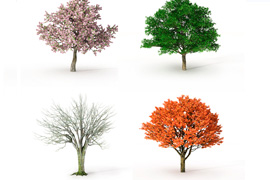September 8th, 2016
Seasons of Healthcare
Elizabeth Donahue, RN, MSN, NP-C
Here in New England, the temperatures have started to dip in the evenings and the sun is setting earlier by the day. These changes are noted and commented upon during exchanges in coffee shops, the local market, and literally over the water cooler in my office. And this past weekend, my family, friends, and I sat on our local beach, soaking up what we all feared was the last of the summer sunshine (wearing a little less SPF than we would normally), and watching our neighbors haul their dinghies and kayaks home — all quietly acknowledging Labor Day as the end of summer.
While I welcome the season of “Pumpkin Everything” and look forward to pulling out my favorite sweaters (and putting my white pants and sandals in their respective places in the closet), I find myself thinking about what is to come in my work — how the changing of seasons affects primary care.
 I’ve noted over the years that various conditions and complaints tend to occur in conjunction with particular seasons. So, as we say farewell to beach days and weekend trips to Cape Cod, in healthcare we are expecting a downturn in the number of visits and complaints centering around poison ivy exposures and tickborne illnesses. The calls coming in will be less and less likely to be related to injuries sustained while rock climbing and competing in office softball games.
I’ve noted over the years that various conditions and complaints tend to occur in conjunction with particular seasons. So, as we say farewell to beach days and weekend trips to Cape Cod, in healthcare we are expecting a downturn in the number of visits and complaints centering around poison ivy exposures and tickborne illnesses. The calls coming in will be less and less likely to be related to injuries sustained while rock climbing and competing in office softball games.
Instead, we have stocked up on flu vaccine supplies. We will start to triage calls about nasal congestion, fevers and sore throats. And soon after those calls peak, we will likely start examining patients with suspicion of rotator cuff and ligamentous knee injuries sustained while skiing and snowboarding.
Aside from these notable swings in urgent care issues based on outdoor temperatures and activities, there are even more subtle ways that the weather and season may have affected our patients. Some patients with diabetes or high blood pressure confess that summer is “harder” because it’s too hot to exercise or their weekends are full of outdoor barbecues, family reunions, etc. Others say they prefer it because foods are lighter and fresher (it’s easier to eat a salad in the summer than a large bowl of pasta), or because they have a pool where they can regularly swim for exercise.
We also have even more overt nods to the changing seasons in health care. We have an “allergy season,” a “cold and flu season,” and even “seasonal affective disorder.” We wear red in February to raise awareness about heart health, and October is widely known as Breast Cancer Awareness Month. (As an aside, when I looked these up on the internet to verify that I had my dates correct, I found several obscure designated health awareness days, weeks, and months that I’d never heard of, like “National Distracted Driving Awareness Month” and “World Sepsis Day”, including 45 acknowledged awareness events in the month of May alone.)
The change of season reminded me that healthcare is cyclical; by its nature, it is integrally tied to the cycles of life – bringing to mind the lyrics penned by Pete Seeger and made famous by The Byrds, all essentially plucked up from the Book of Ecclesiastes as they apply to our lives and our work in healthcare:
To everything (turn, turn, turn)
There is a season (turn, turn, turn)
And a time for every purpose, under heaven



Nice holistic view, Elizabeth!